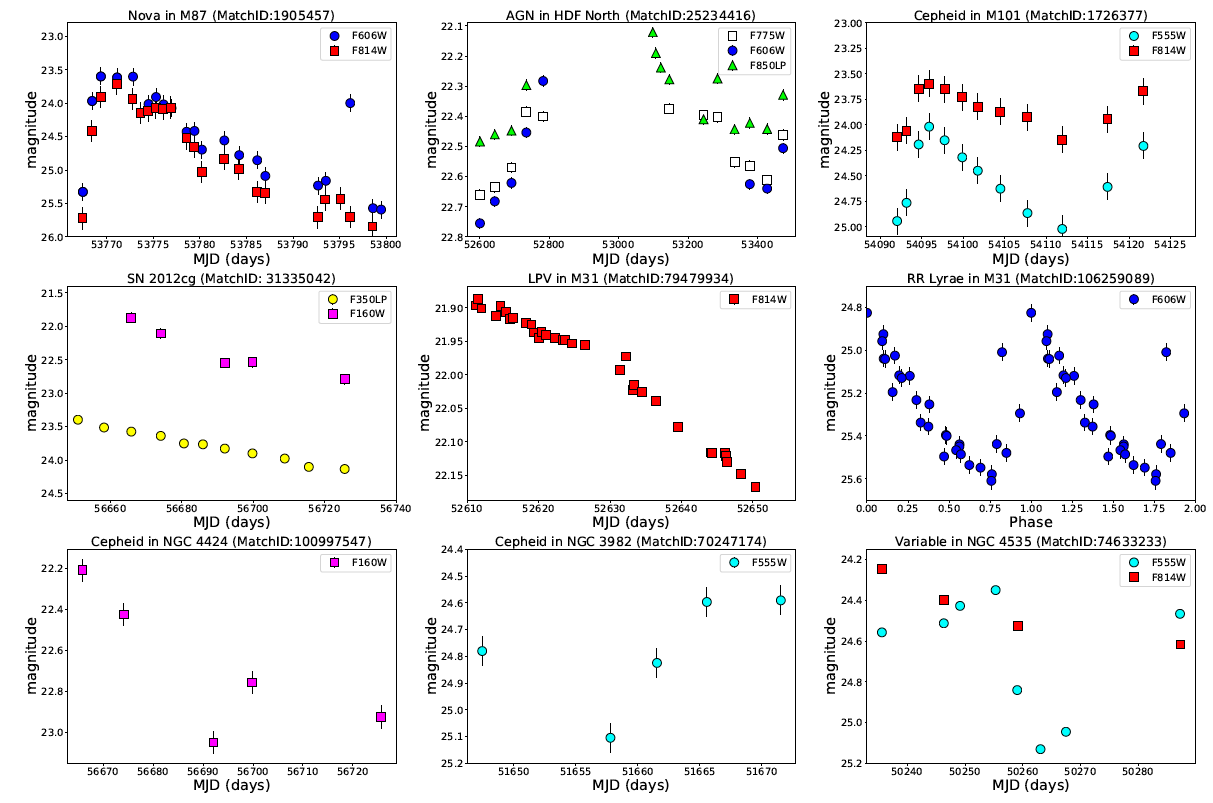Mission Overview
Hubble Catalog of Variables (HCV)
Primary Investigator: Alceste Bonanos
HLSP Authors: Alceste Bonanos, Antonella Nota, Paule Sonnentrucker, Rick White
Released: 2019-09-24
Updated: 2019-09-24
Primary Reference(s): Bonanos et al. (2019)
Citations: See ADS Statistics
Slideshow
Overview
The Hubble Catalog of Variables (HCV) is the first full, homogeneous, catalog of variable sources found in the Hubble Source Catalog (HSC), which is built out of publicly available images obtained with the WFPC2, ACS and WFC3 instruments onboard the Hubble Space Telescope. The HCV is the deepest catalog of variables available. It includes variable stars in our Galaxy and nearby galaxies, as well as transients and variable active galactic nuclei. The HCV contains 84,428 candidate variable sources (out of 3.7 million HSC sources that were searched for variability) with V <= 27 mag; for 11,115 of them the variability is detected in more than one filter. The number of data points in a light curve range from 5 to 120, the time baseline ranges from under a day to over 15 years, while ~8% of variables have amplitudes in excess of 1 mag. Two catalogs are provided in this HLSP: a catalog of variables, and a catalog of objects that are "constant" within 5-sigma of their median absolute deviation (MAD).
The catalog of variables lists for each source the equatorial coordinates, MatchID, GroupID, subgroup, the pipeline classification flag, the expert-validation classification flag, the number of existing instrument and filter combinations for the source, the name of the instrument and filter combination. The filter combination includes: the filter detection flag (set to "1" if variability is detected, or "0" if not), the variability quality flag, the number of measurements in the light curve, the HSC magnitude, the corrected magnitude, the MAD value, and the reduced chi^2 value. For all multi-filter variable candidates, there are extra columns for each additional instrument and filter combination, in which the source is classified as a variable candidate.
The catalog of constant sources contains the sources that fall below the 5-sigma detection threshold of the HCV pipeline. These include constant sources and low-amplitude variables that are below the detection threshold. For each source, the columns show the equatorial coordinates, the MatchID, the GroupID, the subgroup, the number of instrument and filter combinations in which individual sources are observed, follwed by the name of each instrument and filter combination for which the following data are given: the number of measurements in the light curve, the HSC magnitude, the corrected magnitude, the MAD value, and the reduced chi^2 value.
Data Products
The two catalogs, and associated README files, follow this naming convention:
hlsp_hcv_hst_wfpc2-acs-wfc3_all_multi_v1_<ext>
where:
- <ext> is the data file type
Data file types:
| _casjobs-detailed.{csv,fits}.gz | Catalog of detailed properties of each match in the HCV (match, filter, and epoch of observation). |
| _casjobs-filter.{csv,fits}.gz | Catalog of source properties for a match and filter in the HCV. |
| _casjobs-match.{csv,fits}.gz | Catalog of source properties of each match in the HCV. |
| _casjobs-readme.txt | README file for the CasJobs files describing their content. |
| _simbad-table2.dat.gz | Catalog of variable candidates detected above the 5-sigma threshold. |
| _simbad-table3.dat.gz | Catalog of sources found to not be variable at the 5-sigma detection threshold. |
| _simbad-readme.txt | README file for the Simbad files describing their content. |
Data Access
The HCV catalogs are available in a variety of services, including the HCV Explorer developed by the ESAC Science Data Centre.
-
Search the variable object catalog through the catalogs.mast web form. The same form can be used to query the Hubble Source Catalog v2 or v3.
-
A new online web tool to access and visualize the HCV. Developed by the ESDC, the tool offers interactive and connected exploration of the HCV.
-
A web-based SQL interface to query and cross-match between catalogs. Export tables, saved queries, long query submissions.
-
Python notebook tutorial on how to use the HCV using the HSC catalog interface API. Simpler to use, but less powerful, than the CasJobs module.
-
Python notebook tutorial on how to use the HCV using the MAST CasJobs module. More powerful, but more complex, than the catalogs interface API.
The README and catalog files may also be downloaded in their entirety using the table below. The CasJobs files contains the tables available in MAST CasJobs in compressed .csv or FITS format, while the Simbad files contain the tables available in Simbad as compressed .dat text files.






